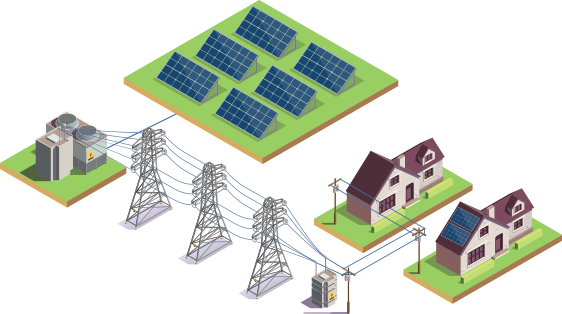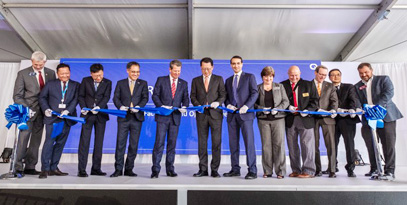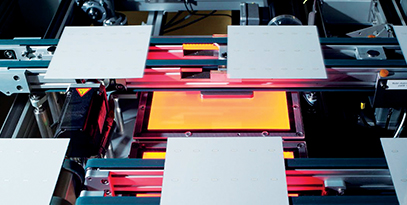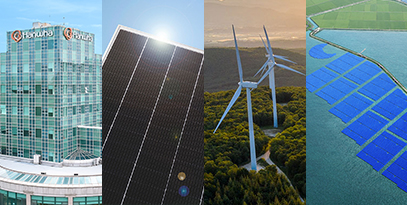Let the sun shine in
Let the sun shine in
A brighter energy outlook, powered by U.S solar
With its ability to generate clean electricity while removing concerns about energy supply and depletion of materials, solar power stands to be one of the main facilitators of society’s transition away from its long-standing dependency on fossil fuels.
But the solar path is not a single-lane track – over time, societies have discovered a wide range of ways to harness the sun’s energy. For most, solar panels would come to mind first, as photovoltaic (PV) solar panels, which convert light into energy, have long been in the public eye. However, with the solar sector only growing more expansive and multi-faceted by the year, this form of generation only scratches the surface of the potential-filled industry.
The heat and light produced by the sun can be harnessed through a range of constantly-evolving technologies. Among this diverse range of capture, storage and transformation methods are PV systems, air and fluid-based condensers, and even oil and molten salt-based heat transfer platforms.

The systems for harnessing solar power are broadly classified as either passive or active. Whereas active systems (like those mentioned above) contain specialized devices that convert the power from the sun into other forms of energy, establishing a passive solar system might involve positioning a building so that it faces the sun, building it out of materials that retain heat and designing its spaces so as to optimize airflow.
Once paired with the ready availability of solar energy, these diverse methods of capture, storage and transformation render the solar sphere an exciting prospect as societies look to sustainably shift their energy supply to renewable sources. Innovation and expansion in the sector has additionally led to solar solutions becoming increasingly affordable, turning solar into an environmental and economic rising star.
As nations look to significantly increase their uptake of renewables, the U.S. has emerged as a globally prominent solar market – an important mantle in a world where the portion of total renewable energy drawn from solar is expected to more than triple between 2019 and 2050.
The Solar Energy Industries Association (SEIA) and consultancy group Wood Mackenzie report that the U.S. solar market has grown at an average rate of 49% per year for the past ten years. And that rapid growth is not expected to slow any time soon, with Wood Mackenzie additionally forecasting 33% annual growth for U.S. solar in 2020, and 113 GWdc of additional solar installed between 2020 and 2050.
Graph Image of U.S. PV Installation Forecast, 2020-2025E. Source: Solar Energy Industries Association (SEIA) & Wood Mackenzie Based on Wood Mackenzie data from U.S. utility PV installations and forecast, 2017-2025E, https://www.seia.org/research-resources/solar-market-insight-report-2020-q2. All rights reserved; as modified by Hanwha.
But this growth hasn’t come out of nowhere – America’s solar ascension has in fact been the result of combined public, private and regional efforts. Federal and state government policies such as the Investment Tax Credit (ITC) and Renewable Portfolio Standards (RPS) have allowed solar to flourish, while continually declining prices and a growing public awareness of the environmental and economic benefits of solar have also driven the industry forward.
46% More than four-in-ten homeowners in the U.S. have seriously considered installing solar at home. Homeowners in the West Pacific region showed the most interest. Source: Pew Research Center Based on survey conducted Oct. 1-13, 2019, https://www.pewresearch.orgfact-tank/2019/12/17/more-u-s-homeowners-say-they-are-considering-home-solar-panels. All rights reserved; as modified by Hanwha.
And as the speeding train that is U.S. solar has powered onward, the state of California has served as its engine. Its high rate of insolation (exposure to the sun’s rays) and favorable state government measures have put California at the fore of U.S. solar development, with the California Energy Commission setting a goal of meeting 100% of the state’s electrical needs with clean energy by the year 2045. In 2020 California also passed legislation mandating the installation of solar panels for all newly constructed single and multi-family homes up to three stories high in the state.
With these factors and more in play, the U.S. is expected to keep blazing the trail for solar and the renewable energy transition for years to come.

But for the solar sector to continue to grow in the U.S. and beyond, the industry must first be underpinned by the high-performance, versatile technology upon which it was founded.
Based in Irvine, California, energy solutions provider Q CELLS, a Hanwha company, is helping U.S. solar users realize the practical means with which they can harness eco-friendly energy and reduce the harm being done by global warming. With a long history and comprehensive know-how in the solar sector, Q CELLS has established itself as a renowned total energy solutions provider in the areas of solar cells, modules, energy storage, downstream projects and energy retail.
In 2019, Q CELLS earned the top spot in both the U.S. residential and commercial solar module markets, increasing its market share in the residential sector in particular from 14.1% to 25.2% between 2019 and 2020, according to Wood Mackenzie Power & Renewables. Having established its leadership in the influential U.S. solar market, Q CELLS will continue utilizing its innovative technology and manufacturing excellence to help lead the charge towards a sustainable future.
Shane (Sunghoon) Kim, Vice President of Sales for Hanwha Q CELLS America, spoke about the company’s solar leadership and unpacked what exactly it takes to become a global and regional renewable energy leader:
 Shane (Sunghoon) Kim
Vice President of Sales for
Shane (Sunghoon) Kim
Vice President of Sales for Hanwha Q CELLS America
-
Q1What makes the U.S. solar market different?
The U.S. market is different in that it values efficiency and quality above all else. It is a large, sophisticated market, typically second each year globally by number of megawatts installed, and next-generation products in our industry typically show up in the U.S. before anywhere else. Further, the U.S. supports strong residential, commercial, and utility-scale solar sectors, meaning it is more robust and diversified.
-
Q2What distinct technological innovations
can be seen in Q CELLS energy solutions?We firmly believe that Q CELLS provides the best solar products on the market, offering the best value for the majority of customers. Our Q.ANTUM solar cells paved the way for today’s higher efficiency solar products and we have sold more of this type of technology than any other vendor.
However, our expertise spans beyond just solar cells and panels to storage, project development, O&M, engineering, procurement, and construction. We partner with leading technology companies across the industry, and this allows us to provide customers with complete energy solutions that are backed by the Q CELLS name.
-
Q3What factors have allowed Q CELLS to achieve its market prominence in the energy sector?
Our market position can be directly attributed to the backing of the Hanwha Group, a Fortune Global 500 company, and the twenty-plus year history of the Q CELLS brand. Customers know that they can rely on us to meet their needs and that they can trust us to be a long-term partner. In an industry as unpredictable as solar, this allows us to stand out.
-
Q4What are some exciting prospects and innovations specific to the U.S. solar market?
The U.S. solar industry is special for its commitment to quality. This focus is found on both the product and system level, which means that installation costs are often higher than in other countries. Technical innovations often appear in the U.S. first as a result.
A fascinating aspect of the U.S. market is how much it varies state-to-state. Each state manages its own electricity industry and there are thousands of utilities nationwide. As a result, the companies that are most successful in solar are the ones that best understand the intricacies of each market and tailor their strategies appropriately.
Some innovations we’ve seen that are specific to the U.S. market are module-level power electronics like microinverters and DC optimizers, single-axis trackers, rail-free installation systems, and several panel technologies that enable higher efficiency and greater shade tolerance.
-
Q5What is it that makes solar such an exciting area for the future of energy generation?
Solar is now the lowest cost form of new electricity generation in most places in the world. It is an integral part of transitioning our planet to clean energy on a systematic basis, and it also allows homeowners to lower their electricity bills and their own carbon footprints. This is an industry that has been continuously growing for decades, yet we still account for only a single-digit percentage of the world’s electricity generation and thus have ample room to grow further.
All things considered, photovoltaic solar panels remain among the solutions best-positioned to facilitate the transition to renewable energy generation.
But for the solar industry to truly thrive, users also need ready access to established solar infrastructure. Thus, as the solar market expands and looks to reach more users, the industry is diversifying its offerings to ensure that consumers have access to a wide range of delivery options for their clean energy.
One of those options is that of ‘retail solar energy’, by which an energy retailer provides the user with their electricity, instead of them being required to get it from a traditional utilities provider. In the case of retail electric providers (REPs) such as Chariot Energy, clean energy is generated at expansive solar farms, before being transmitted directly to users. This system of solar delivery allows residents and businesses to enjoy solar energy without the need to install their own rooftop panels.
As a retail affiliate of 174 Power Global, which is an arm of Hanwha Group, Chariot Energy is the first REP in Texas to include solar energy in every plan it offers. Those plans use Solar Renewable Energy Certificates (SRECs) to offset users’ energy usage. SRECs are credits that represent all of the renewable electricity on the market today and allow customers to tell whether the energy they are purchasing is green or not.
Our sun is constantly releasing immense amounts of energy, but only a fraction of that energy actually strikes the earth. Still, according to the U.S. National Oceanic and Atmospheric Administration, approximately 173,000 terawatts of solar energy strikes the earth continuously, which is more than 10,000 times the world’s total energy use! What’s more, that energy is carbon-emission free, non-resource-depleting, and effectively inexhaustible.
As the global community works toward greatly increasing the amount of energy it draws from renewable sources, solar solutions providers are producing the technology to underpin that transition and diversifying their delivery options to bring the clean energy produced by our sun to the world.




























